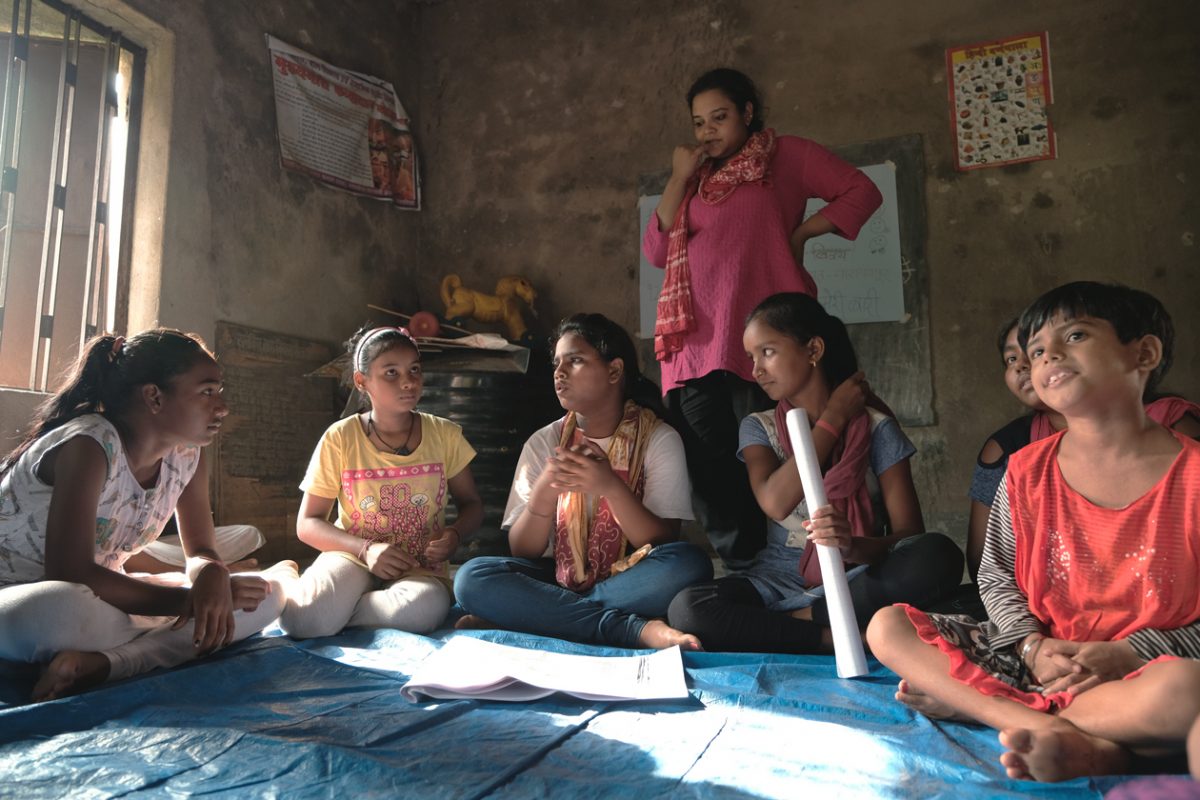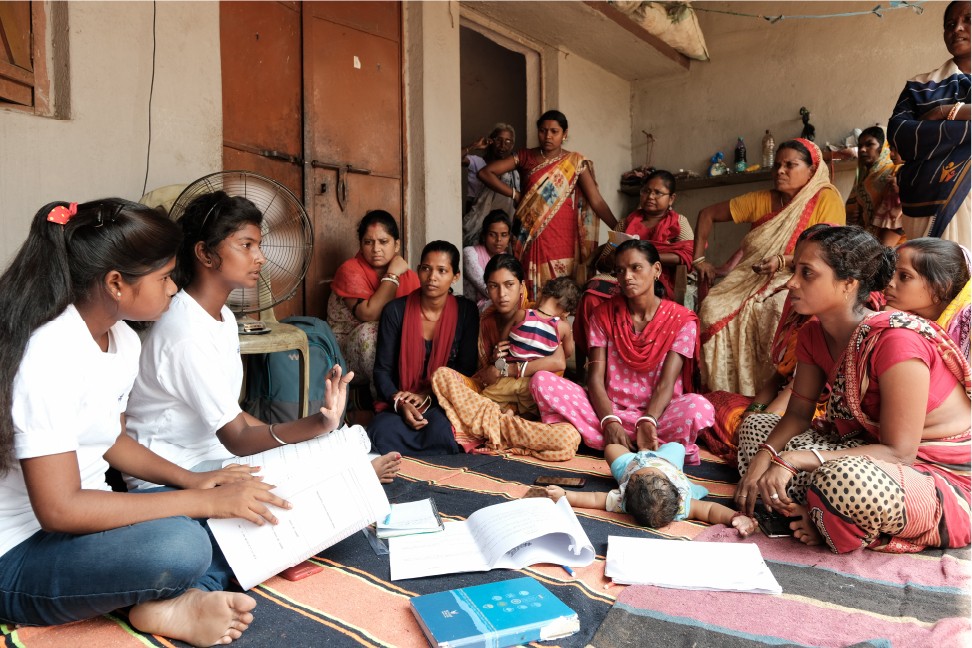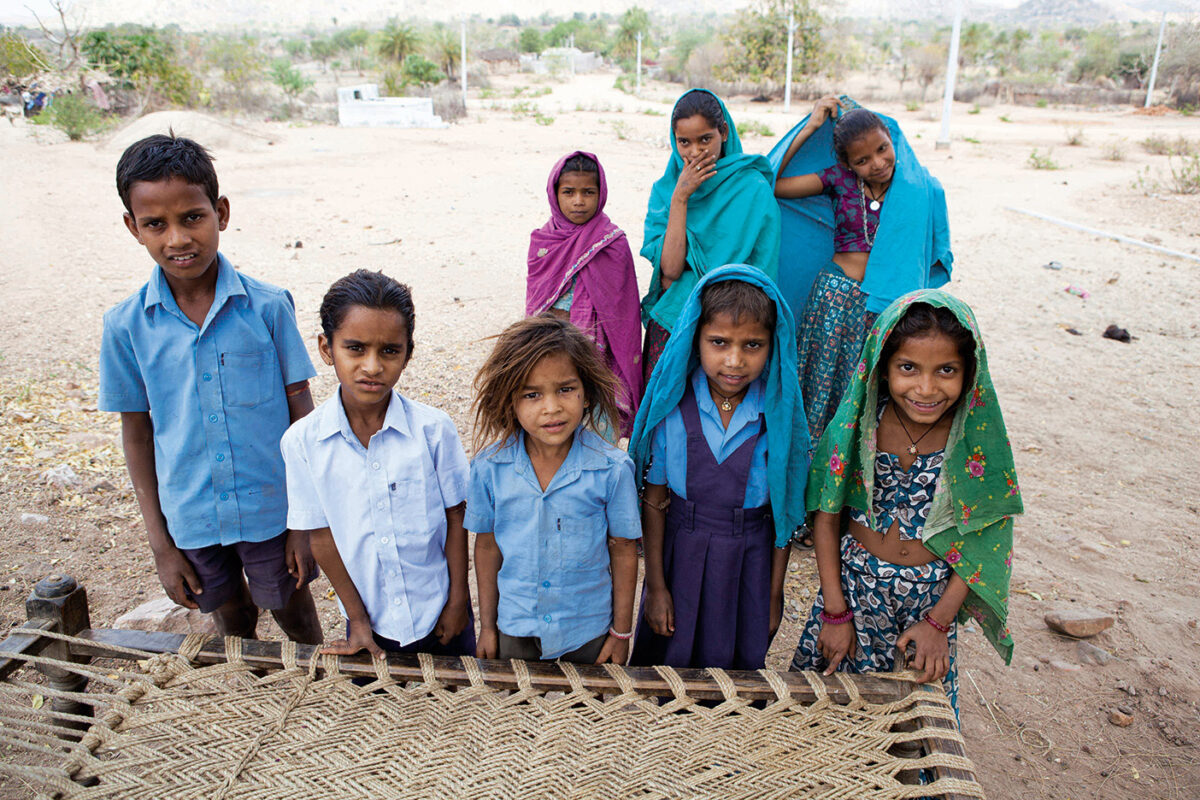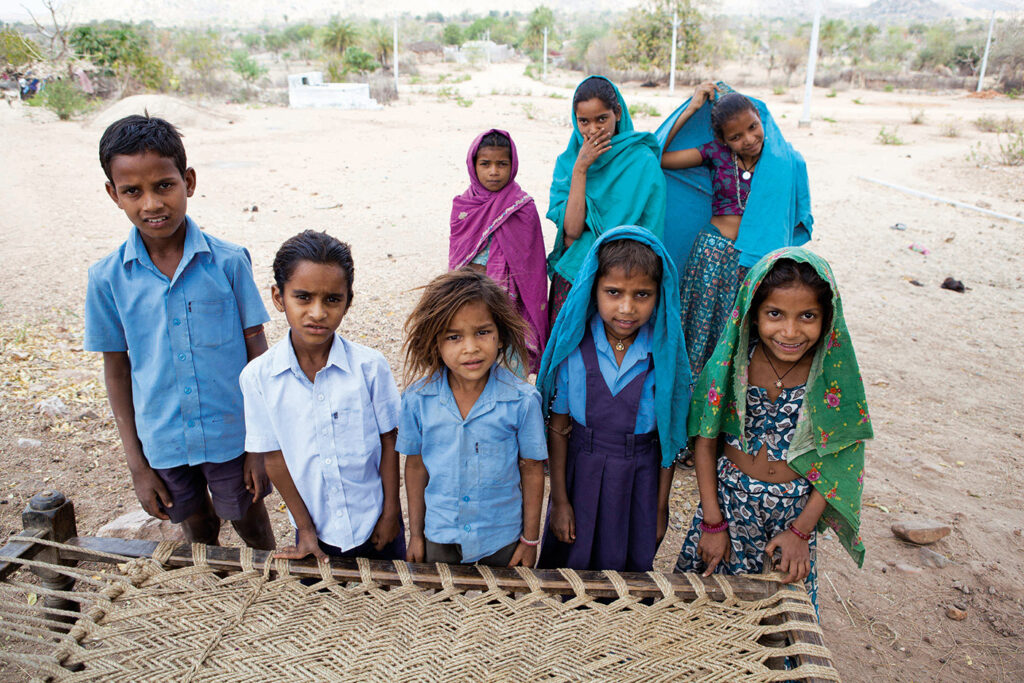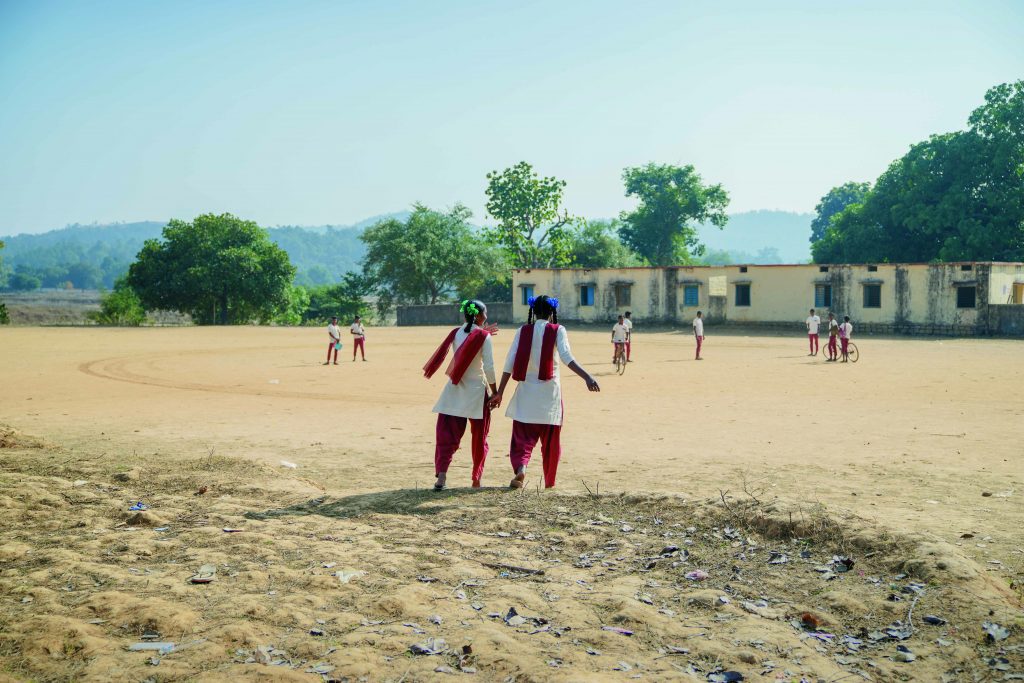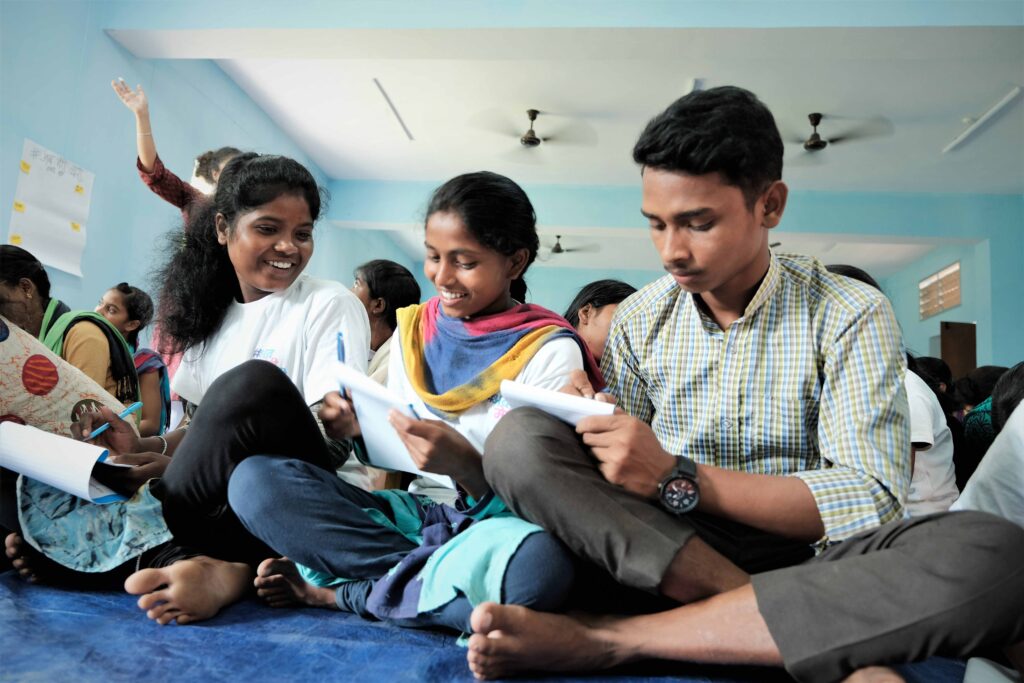
Voices from the Ground | Re-imagining working with Adolescents
sucharita iyer
Introduction
The onset of the COVID 19 pandemic has set the clock back on progress achieved when it comes to adolescent health in India, with adolescents across the country facing challenges across many important aspects of their health, including nutrition, sexual and reproductive health and mental well-being. On the supply side, the community health workers, ASHA, ANM and Anganwadi Workers (AWWs), mandated to address emergent adolescent health issues in the community, are over-burdened with COVID-19-related care and vaccination drives, causing delays in their other responsibilities. This has impacted benefits for adolescents mandated under the central flagship scheme, Rashtriya Kishore Swasthya Karyakram (RKSK), which run the risk of being delayed or denied to them. Supply of iron-folic acid (IFA) tablets, sanitary napkins, provision of supplementary nutrition, and immunization activities are among the initiatives that is currently facing gaps in demand and supply. It is thus imperative to sustain and further accelerate the advances made in the past decade with regard to addressing access to sexual and reproductive health needs, educational and nutritional outcomes, safety and child marriages, while building resilience and adaptability to adjust to post-pandemic realities. Addressing the unmet needs of youth should be a priority area of intervention, both for the state and civil society.
In the absence of sufficient evidence surrounding the situation and needs of vulnerable sections of the population, various response systems had expressed concerns in reaching out to them, compounded by the huge digital divide and restrictions on mobility. But even during the lockdown, several civil society organisations had initiated action for young people, either in partnership with the state or as civil society coalitions and networks. The vital role played by civil society in India during times of disasters and crises, in supplementing the state’s efforts at providing welfare was aptly demonstrated during the disruptive waves of pandemic. Recognizing and acknowledging the transformational potential of civil society to impact adolescent health and well-being forms the core of discussions. There is a need to explore how different organizations working on adolescent health have strategized their operations to adapt to the changing environment.
Objective of the Learning Circle
The devastating second wave of COVID-19 has had a severe impact on NGOs, adolescents and communities. Over the course of previous one year, several knowledge sharing and dissemination initiatives have brought forth the challenges faced by the adolescents and civil society working in the domain of adolescent health. However, it is also important to share the lessons learnt as a result of conducting interventions with adolescents in the midst of a pandemic and to deliberate on the ways in which civil society should re-align their operations, programs and interventions to suit the needs of a post-pandemic environment.
To have deeper discussions on these issues, PRIA and 10to19 Community Dasra hosted a virtual learning circle on “Re-imagining working with adolescents”. The objective of the learning circle (LC) was to enable intra-civil society conversations around revising existing
strategies of working with adolescents. The LC will also provide a platform to CSOs to share their learnings, strategies and plans to scale their operations and increase outreach in the coming years. The discussions will enable co-creation of a sustainable roadmap for civil society organizations, either working or intend to work with adolescents.
This learning circle was aimed at addressing the following key questions:
- During the pandemic, what strategies did you adopt to deliver interventions or implement adolescent health programs? Has the arrival of pandemic forced you to depart from existing models of interventions?
- What modifications or innovations have you integrated into your strategy, as opposed to preceding years while working on adolescent health?
The first section of the learning circle was designed to interact with five thematic speakers on the following themes:
Dr. Indrani Bhattacharya (CEO, Child-In-Need Institute) spoke about how civil society can sustain the progress made in achieving SDGs related to sexual and reproductive health in the previous decades. She spoke about the post-pandemic perspective of adolescent health, with a focus on states from eastern India like Jharkhand, Assam and West Bengal. In the absence of state authorities, who were engaged in pandemic alleviation efforts, to monitor adolescent health situation, CINI intervened in the states by undertaking a situational analysis to understand the ground situation. The results of the situation analysis point towards the need for civil society to intervene:
- Adolescent health programs, like Rashtriya Kishore Swasthya Karyakram (RKSK) were neglected since the state authorities were busy with pandemic management.
- The frontline health workers were engaged in pandemic alleviation and involved in activities related to vaccination drives. Thus, distribution of sanitary napkins, menstrual hygiene products and Iron Folic Tablets had taken a hit.
- Health systems had seen an imminent collapse, which was exacerbated by the undue burden exerted due to COVID-19 cases. In such a situation, it was observed that Adolescent Friendly Health Clinics were not functional.
- Incidents of sexual violence within families, teenage pregnancies and unsafe abortions reported an exponential spike, as was evidenced through increasing SOS calls.
We have started trainings with adolescent boys and girls to build their capacity to make their digital space safe. We have also developed learning materials. It is also important for civil society working with adolescents to build capacity of their own staff to adapt to the hybrid model”
Indrani Bhattacharya, CINI
In order to address the state of vulnerability the following interventions were mooted:
- The immediate mode of outreach was to adapt to online and virtual spaces. However, the digital divide in India remains an obstacle to sustained outreach. Only 7-8% of the adolescents in rural areas and 16% in urban areas have access to digital space.
- As important as the need to conduct outreach through digital means is the need to create safe digital spaces. Adolescents could be made aware of the importance and ways of creating safe spaces by developing learning materials and online modules.
- In order to close the gap in health service delivery and to connect the adolescents to health care providers, WhatsApp groups were created with adolescents, where nodal health officers and Government doctors were present. Their presence in groups enabled easy referral and doubt-clearing.
- The new normal has mandated innovative ways of working and connecting with community. Hence, it is imperative that organizations build capacity of their staff to remain flexible and adapt to changing modes of working.
- Speaking about mental health, Rhea Sharma, Intervention Director, Sangath highlighted how civil society can integrate mental health as an important component of pandemic
management and the ways in which access to mental health services for marginalized and vulnerable communities can be improved. - Rhea spoke about the experiences from her organization, Sangath, which has adapted to digital technology to deliver mental health counselling and believes in taking mental health to the communities. Long before the pandemic, Sangath developed an intervention targeting school-going adolescents in under-resourced communities.
- As the pandemic struck and schools remained shut indefinitely, an educational mobile application was used to enable young children to tackle clinically diagnosable symptoms of mental health like depression, anxiety, anger and behavioral issues, all of which had flared up in first and second wave of the
pandemic. It was, however, important for the adolescents to refer themselves, as counsellors were not able to reach out to adolescents physically. The app would feature characters with similar symptoms as the adolescent. In connecting adolescents to health services and increasing the scope of outreach, Sangath had offered tele-counselling services.
Through digital interventions like problem-solving mobile applications, it was possible to work on 70% of clinically diagnosable symptoms of mental health like stress, depression, anxiety, anger issues, behavioural problems, all of which flared up during the second wave of pandemic, with adolescents in under-resourced communities.”
Rhea Sharma, Sangath
Dr Rama Shyam, program director, SNEHA offered insights for civil society to focus on addressing the glaring gaps in adolescent nutrition.
“Food insecurity was one of the biggest stressors that young people and parents talked about during the pandemic. No one wanted to talk to us about corona virus, they wanted to talk about food, at least one meal in a day” remarked Dr. Shyam as she indicated that the food crisis would worsen in days to follow since the gaps in nutrition has not been bridged in a coherent manner. The Global Nutrition Report, published in 2020 and India’s standing is evidence enough that demands targeted nutrition delivery for adolescents, especially belonging to under-resourced communities.
Through digital interventions like problem-solving mobile applications, it was possible to work on 70% of clinically diagnosable symptoms of mental health like stress, depression, anxiety, anger issues, behavioural problems, all of which flared up during the second wave of pandemic, with adolescents in under-resourced communities.” ~Rhea Sharma, Sangath
5
SNEHA’s approach has been focused on targeting anemia through appropriate intervention. However, the post pandemic induced restrictions in movement, Dr. Shyam argues, has had an impact on nutrition. There was no way to ascertain if those who had found success in intervention were actually slipping back into their old state. Some of the solutions, as mooted by the speaker were:
- In order to generate evidence into pandemic- induced anemia indicators, SNEHA had developed SOPs and protocols to carry out anemia testing, with adequate physical distancing measures.
- The mid-day scheme had been paused due to indefinite shutting of schools. In order to promote better nutritional outcomes among adolescents, especially belonging to vulnerable communities, ration kits were targeted to deliver high protein food items.
- Public Distribution System (PDS) was targeted to ensure that more communities get
access to food. However, it was equally important to plug the holes in distribution system to ensure zero leakage. A participatory approach to PDS monitoring was devised, with the help of community youth volunteers. The process began with mapping of 100 ration shops, across the city of Mumbai, which was followed by SNEHA facilitating interaction of the community with the PDS officials. The ensuing linkage enabled the communities to battle hunger at a time, when the poor of the country and vulnerable were not able to access or afford food supplies. - In addition to addressing nutritional deficiencies through ensuring adequate food supplies and ration shop linkages, another area of intervention included de-worming and iron-folic tablets.
We realized that just GEHU-CHAVAL won’t work in dry ration kits. So, we consciously curated dry ration kits and included micro-nutrient rich foods like ragi rajma, soya chunks, kala chana to the dry ration kits, along with sanitary napkins”
Dr Rama Shyam
Some of the other initiatives, that took the form of digital interventions include mobilizing youth volunteers to create their own SBCC videos on topics like anemia for circulation in the community and mobile banks. ‘Mobile banks’ is an initiative for increasing digital uptake among adolescents so that they can access informational videos and connect to mental health tele- counselling services or SOS helplines in the event of domestic violence. Five youth in the community will have access to a common smartphone, which is shared among them for their common use. It is also an attempt to strengthen peer interaction.
We got youth volunteers to create their own videos to explain nutrition, consequences of anaemia and to distribute them to parents and youth. Now the youth volunteers are conducting awareness sessions on nutrition in their neighbourhood”
Dr Rama Shyam, SNEHA
During the subsequent waves of pandemic, incidents of violence and child abuse was seen to increase at an exponential rate. Since public spaces were closed, mobility was restricted and adolescents were staying within the confines of their homes, it was important to explore the impact of violence on well-being of young people. Often, within the realm of adolescent health, violence is not considered an area of priority as much as areas like SRH and mental health. Ms. Nandita Bhatt, Director, Martha Farrell Foundation, spoke about the role that civil society can play when it comes to tackling violence against adolescents.
Nandita drew attention of participants towards the concept of ‘safe spaces’. When children come from their homes to a safe space, it provides them an opportunity to engage in “difficult conversations”. After the pandemic, it is important for civil society to ideate on how such conversations can be held with young people when they are in their homes. This thought also finds convergence with the point raised by Dr Indrani Bhattacharya with regard to training adolescents and facilitators to create safe online spaces.
Even as the adolescents are provided with opportunities to reach out through online spaces, it is important to understand the power dynamics behind access to technology. Mostly the adolescents do not have access to technology ad it is important to also consider to not leave them with backlash after conducting the session.
- Language should be made inclusive, help adolescents teach acceptance, how they learn to negotiate power, how they learn to communicate consent,
- As civil society as we work with adolescents, it is important to help them develop this thinking.
- Develop a mechanism where adolescents develop awareness, defining and identifying threats
Child Marriage is an issue that needs social capital for intervention, remarked Srabonti Ghosh, Aangan Trust as she spoke about how child marriages had reported an increase, especially in backward districts across India.
Globally, one in three child brides are from India. However, as the pandemic progressed, a situation where adolescents were losing their voice was increasingly observed. It was also impossible to connect with peer groups. In families with dismal economic conditions, it was a blessing in disguise, where they could conduct marriages at less than the normal cost and lesser amount in dowry. She quoted the example of Bihar, where marriages were solemnised at less than “25% of the actual cost incurred as opposed to other times.’
In order to prevent child marriages, it is important to secure community participation in efforts. However, sufficient caution should also be exercised to not pin all responsibilities on the communities to prevent harm. Hence, activate the social capital around to understand the local story. The experience of community volunteers, adept in local language and context, can be leveraged to collect local stories so that adequate intervention strategies could be designed. Building social capital is also a strategy to understand the stakeholders, who can then be included in preventing child marriages..
Another strategy , as mentioned by the speaker, was to create whisper circle, which is a network of community women coming together to create a safe space to understand who the decision maker in family is so that they can negotiate and bring cases of child marriages down.
Increasing agency through empowerment of girls, opening channels for girls to reach out like digital helplines, working with local elected bodies like panchayats, involving frontline health workers like Accredited Social Health Activists (ASHA) and ANM were also mentioned as strategies to understand the risk factors that motivate child marriages and in designing strategies for effective intervention.
Looking at everything from preventive mode and building social capital were crucial to stopping child marriages”
Key takeaways
- While working with adolescents, community advocacy, civil society partnerships and capacity building are the strategies that work best, if sustainable outcomes are to be seen as part of interventions.
- Use of digital spaces and how we negotiate with the owners of the spaces, be it parents, schools, communities matter a lot.
- Promoting inclusivity within the overall program design and intervention is key to achieving the program objectives. Organizations working with adolescents, especially at the level of communities must strive to reduce the power differential.
Annexure
Profile of speakers
Dr Indrani Bhattacharyya is a social scientist working in the development sector for last 21 years. She has done her PhD in social anthropology and led many programmes on child, adolescent and women health and nutrition issues as well as participatory governance and community partnerships. She joined CINI in August 2001 and she has been trained on child, adolescent and women rights, participatory governance, community mobilisation, reproductive and child health, adolescent sexual reproductive health and rights, leadership development issues from reputed organisations in India, including DASRA, supported by Harvard Management School. Her journey and growth curve in CINI is very inspiring and motivating and in tandem with the growth of the organisation. Currently she is the Chief Executive Officer in CINI. She represents CINI in State, National, Regional and International forum and is engaged in institutional knowledge management, technical assistance and policy advocacy. She is also promoting CINI Method and Child Friendly Community [CFC] approach, which is human rights based approach [HRBA] engaging community, including children and adolescents, service providers and local self-government for sustainable community-owned process through strengthening Government programs on education, protection, health, nutrition and adolescent empowerment. Her core strength and interest are around adolescent sexual reproductive health rights and she is learning through different interventions and policy dialogues at the states and national level in India.
Rhea Sharma is a Psychologist working in the areas of adolescent and youth mental health. She is currently an Intervention Director at Sangath(India) with the PRIDE research programme where she leads the intervention development of a digital intervention for school-going adolescents in low resource settings. Rhea is also leading Sangath’s Covid-19 wellbeing center and tele-counselling service which aims at providing free mental health support to anyone in need, with a specific focus on Frontline and Essential workers. Rhea holds a MA in Clinical Psychology from Fergusson College, University of Pune and an MSc in Global Mental Health from King’s College London and the London School of Hygiene and Tropical Medicine.
Rama Shyam is the Director of SNEHA’s Adolescent Health and Sexuality Education programme. She holds a doctoral degree in Social Sciences from the Tata Institute of Social Sciences, Mumbai, and has over 15 years of experience in both grassroots’ and international organisations, working in the development sector. In her most recent stint, she headed the Education and Citizenship programme with Apnalaya, Mumbai, working on developing a high-impact community engagement programme. Earlier, Rama co-founded SAHER (Society for Awareness, Harmony and Equal Rights), a youth-led organization, working on peace-education, sexual and reproductive rights, leadership and citizenship in Mumbai. She has implemented programs to scale in partnership with organisations such as USAID, United Nations Alliance of Civilisations, Tata Trusts, Magic Bus, US Consulate and many others. Prior to her engagement with SAHER, Rama had stints in academia and in training and capacity building and community development across themes such as peace-education, primary education, governance and youth development. She was awarded the Martii Ahistari Peacebuilder Award in 2012, for her peace-education activities in Mumbai, the Dasra Social Impact Village Capital Award in 2010, the Youth Action Net Fellowship in 2007 and Ashoka’s Changelooms Award in 2017.
Nandita Pradhan Bhatt is the Director of Martha Farrell Foundation, where she’s responsible for program delivery and management of the Foundation. She also heads the gender programs in PRIA (Society for Participatory Research in Asia) and has over 25 years of experience in the space of gender mainstreaming and inclusion. She has trained over 20,000 employees across more than 40 national and international organisations, and has over two decades of experience training informal and formal workers, government officials and college and university-going students in prevention of sexual harassment at the workplace.
She has been working with women domestic workers to train and support their advocacy efforts to strengthen institutional responses to tackle the issue of sexual harassment in their world of work. During the second wave of the pandemic, Nandita spearheaded the Foundation’s efforts to provide essential COVID-19 Relief Kits for women domestic workers, an effort to deliver relief, as well as strengthen a network of over 4000 women domestic workers to advocate for their rights.

